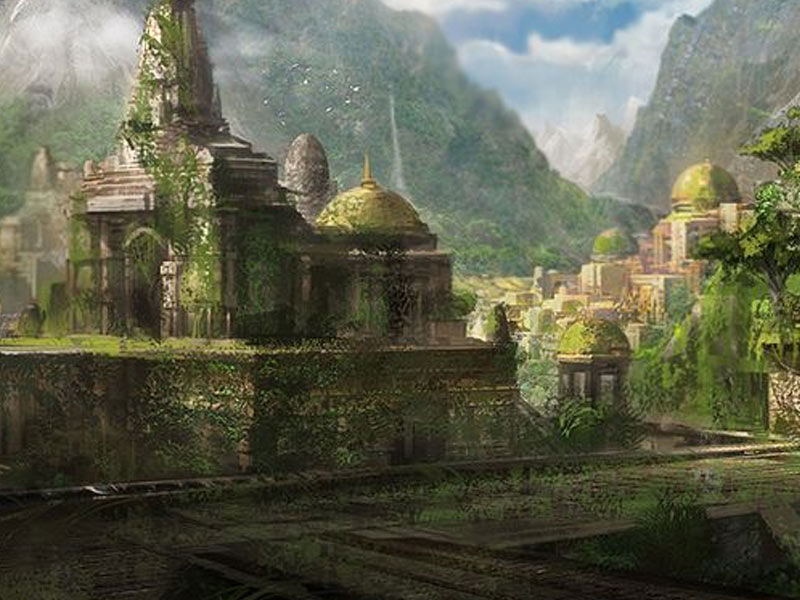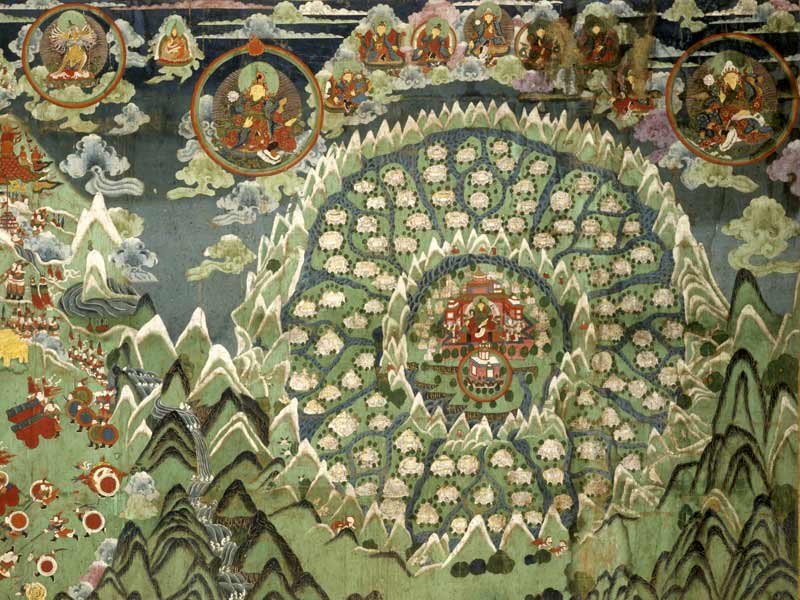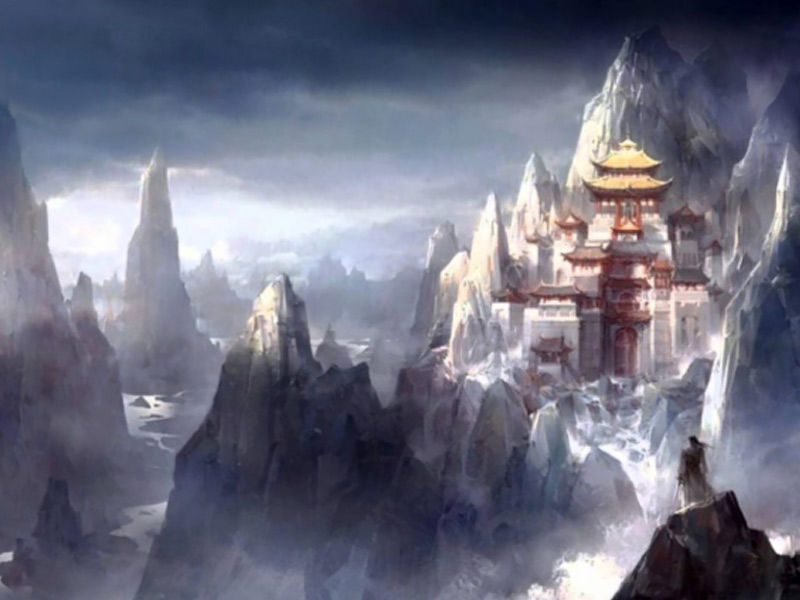The Prophecy…
The notion of Shambhala is significant in Tibetan religious teachings, and it is especially important in Tibetan mythology concerning the future. The Kalachakra foresees a progressive degradation of humanity as the philosophy of materialism expands over the globe. The mists will lift to expose the snowy mountains of Shambhala when the “barbarians” who follow this doctrine are unified under an evil monarch and believe there is nothing left to conquer. The barbarians will assault Shambhala with a massive army armed with heinous weapons. Then the Shambhala monarch will emerge from Shambhala with a massive army to defeat “evil forces” and bring in some kind of a universal Golden Age.
![]()
Though the Kalachakra foretells a future battle, it appears to be at odds with Buddhist teachings that forbid violence. Some theologians have interpreted the fight figuratively, claiming that the Kalachakra does not advocate violence against individuals but rather alludes to the religious practitioner’s inner battle against inner demonic inclinations.
Shambhala…
For thousands of years, there has been a story that somewhere in Tibet, among the high Himalayan peaks and isolated valleys, there lies an unspoiled utopia, a monarchy with unparalleled tranquility and universal policy. Shambhala is a mythological paradise mentioned in ancient literature such as the Kalachakra Tantra and the ancient teachings of the Zhang Zhung civilization, which predates Tibetan Buddhism in western Tibet. Shambhala is a Sanskrit term that means “place of calm” or “place of stillness.” It is a realm where only the pure of heart may reside, where love and knowledge reign supreme, and where people are immune to sorrow, lack, or old age.

The realm of a thousand names, Shambhala, is supposed to be. It is known as Aryavartha (‘The Land of the Worthy Ones’) by Hindus, Hsi Tien, the Western Paradise of Hsi Wang Mu by Chinese, and Belovoyde by Russian Old Believers. The Forbidden Land, the Land of White Waters, the Land of Radiant Spirits, the Land of the Living Gods, and the Land of Wonders have been given. However, Shambhala, Shamballa, or Shangri-la is the name given to it in Sanskrit across Asia.
Shambhala’s tale is claimed to be thousands of years old, and references to the fabled realm may be found in ancient literature. Olmolungring is mentioned in the Bön texts as a closely connected country. Shambhala is mentioned in Hindu writings such as the Vishnu Purana as the birthplace of Kalki, Vishnu’s last incarnation who would usher in a new Golden Age.
The Shambhala tale is a Buddhist version of an older Hindu narrative. The Kalachakra, on the other hand, is the scripture in which Shambhala is first thoroughly explored.
Kalachakra…
In Tibetan Buddhism, the Kalachakra refers to a complicated and profound esoteric doctrine and practice. At the request of King Suchandra of Shambhala, Shakyamuni Buddha is claimed to have taught the Kalachakra. The notion of Shambhala, like many other Kalachakra ideas, is believed to have exterior, inner, and alternate interpretations. Shambhala is a physical place, according to the outside meaning. Still, only those with the right karma may reach it and perceive it as such.

The inner and alternate meanings allude to more deep understandings of what Shambhala symbolizes in terms of one’s own body and mind (inner), as well as during meditation (alternative). Orally, these two forms of symbolic explanations are often passed down from instructor to student.
Also Read, The Mystery behind the 9 Unknown Men
The Kalachakra was passed down via Shambhala’s Kalkis (“chieftains”), and it was finally reintroduced into India. The tale described by the Ra tradition and the account told by the Dro tradition are the two primary versions of how this happened. The Kalachakra Tantra, like all Buddhist tantric systems, is practiced after acquiring the necessary initiations. For initiations to be effectively offered and received, both the guru and the student must have specific qualities.
Losang Chökyi Gyaltsen describes the Mantrayana guru’s credentials as follows: “He should be able to manage his body, voice, and mind. He should be extremely bright, patient, and deceptive. He should be familiar with mantras and tantras, comprehend reality, and be capable of writing and explaining texts “.
Shambhala’s Location…
Many explorers and seekers of spiritual wisdom have embarked on expeditions and quests in search of the mythical paradise of Shambhala. While many have claimed to have been there, no one has ever provided any proof of its existence or been able to pinpoint its physical location on a map. However, most references place Shambhala in the mountainous regions of Eurasia.

Shambhala is associated with the Sutlej Valley in Punjab or Himachal Pradesh, India, according to ancient Zhang Zhung scriptures. Shambhala is associated with several areas in southern Siberia by Mongolians. Mount Belukha is said to be the doorway to Shambhala in Altai legend. According to modern Buddhist academics, Shambhala is located in the Himalayas’ upper reaches, in what is today known as the Dhauladhar Mountains, near Mcleodganj.
According to mythology, the Shambhala Guardians protect the entrance to Shambhala, which is concealed inside a distant, abandoned monastery in Tibet. Chögyam Trungpa, the founder of Shambhala International, stated that the Shambhala kingdom is viewed as an enlightened society that people of all religions may strive to achieve. The road to this is defined as a combination of “secular sacredness,” connecting the knowledge of the past and one’s own culture with the present in nowness, and “warriors,” which involves confronting fear and conquering aggressiveness.
For some, Shambhala has never been discovered as a simple explanation: many think that Shambhala is located on the extreme edge of physical reality, serving as a link between this world and another. While many dismiss Shambhala as a fantastical topic of myth and legend, for others, Shambhala inspires an inner longing to visit this ideal country.




























